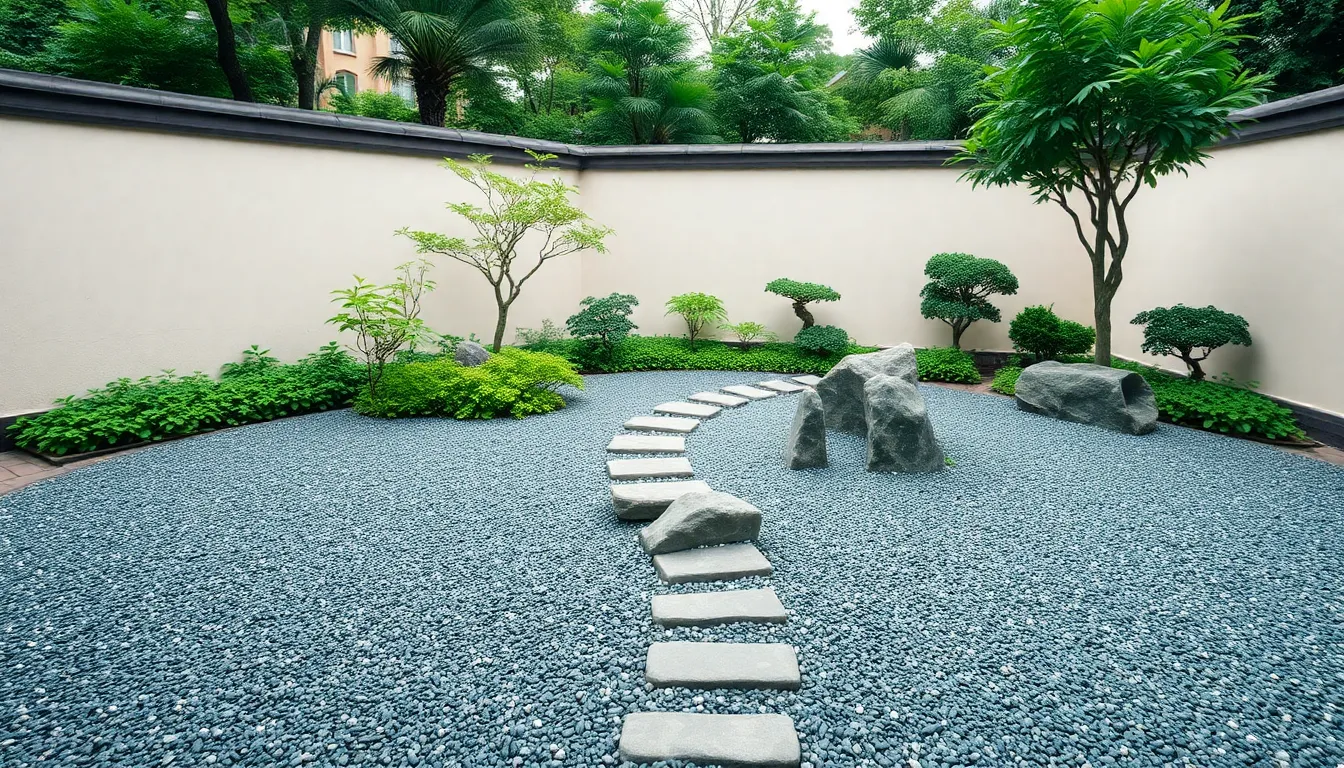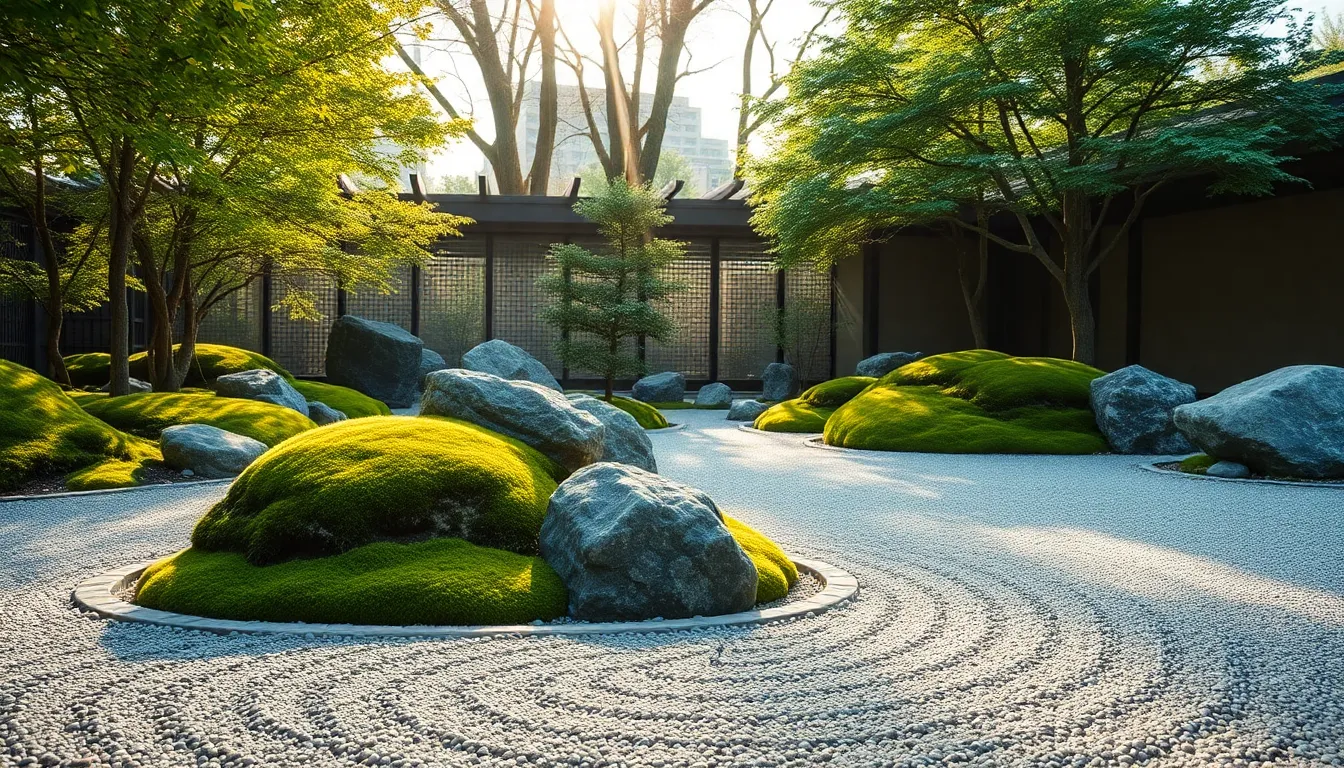A Zen garden isn’t just a patch of sand and rocks; it’s a slice of tranquility that can transform any chaotic mind into a serene oasis. Imagine raking patterns in fine gravel while your worries drift away like leaves in the wind. It’s not just gardening; it’s a meditation session with a side of aesthetic appeal.
Creating a Zen garden offers more than just a pretty view. It invites mindfulness into daily life, encouraging a moment of pause amid the hustle and bustle. Plus, who wouldn’t want to impress friends with tales of their own miniature paradise? Dive into the world of Zen gardens and discover how this ancient practice can sprinkle a little peace and humor into the chaos of modern living.
Table of Contents
ToggleWhat Is a Zen Garden?
A Zen garden, also known as a karesansui, is a traditional Japanese rock garden designed to promote contemplation and tranquility. This specific type of garden features minimalistic elements such as gravel, rocks, moss, and carefully placed plants. Its design emphasizes simplicity and the beauty of nature, encouraging its users to reflect on their surroundings.
Typically, Zen gardens do not include water features, but they can symbolize water through raked gravel or sand patterns. The act of raking these patterns creates a sense of rhythm and calmness, representing waves or ripples. Visitors engage with these spaces to achieve mindfulness, focusing on the present moment while contemplating the natural world.
Creating a Zen garden facilitates a deeper connection with nature. Many individuals use these gardens as a way to escape the hustle and bustle of daily life, finding peace in their serene environments. Additionally, they serve as a medium for formal meditation practices, where practitioners can sit quietly and engage with the garden.
The social aspect of Zen gardens shouldn’t be overlooked. Friends and family often gather to share their experiences or discuss the design, fostering connection. Communities that feature public Zen gardens enable more people to experience these calming spaces and appreciate their beauty.
Through the strategic arrangement of natural elements, a Zen garden cultivates an atmosphere conducive to reflection and serenity. Whether for personal use or communal enjoyment, these gardens embody the principles of balance, harmony, and simplicity, inviting contemplation and mindfulness.
History of Zen Gardens

Zen gardens, known as karesansui, have a rich history originating in Japan. These gardens reflect a deep cultural appreciation for nature and aesthetics.
Origins in Japan
Japanese Zen gardens began to emerge during the Muromachi period (1336-1573). Influenced by Zen Buddhism, these gardens serve as ongoing symbols of meditation and spiritual reflection. Raked gravel represents water, while carefully arranged rocks symbolize mountains or islands. Early examples appeared in temple landscapes, connecting physical space with spiritual practices. Over time, the design philosophy expanded, emphasizing simplicity and mindfulness. Zen gardens focus on minimalism, creating an environment conducive to contemplation.
Cultural Significance
Cultural significance resonates throughout the history of Zen gardens. They serve as retreats for meditation, promoting a sense of peace and tranquility. Many artists and poets draw inspiration from these serene landscapes, enhancing their craft. Shared experiences within these gardens foster community connection and dialogue. Celebrated works, such as the Ryoan-ji temple garden, showcase the historical importance of Zen aesthetics. These gardens illustrate the harmony between human design and natural beauty, embodying principles of balance and simplicity.
Key Elements of a Zen Garden
Zen gardens utilize specific elements to create a serene atmosphere conducive to reflection and meditation. Each component serves a unique purpose, contributing to the overall tranquility of the space.
Rocks and Gravel
Rocks symbolize permanence and stability within a Zen garden. Carefully arranged boulders and stones represent mountains or islands, grounding the design. Gravel serves multiple purposes; raked patterns mimic the appearance of water, enhancing the garden’s contemplative nature. Distinctive textures add visual interest, inviting closer examination. Regular maintenance keeps the gravel pristine, ensuring the patterns remain clear and meditative. Many garden designers emphasize the importance of asymmetry, choosing an irregular arrangement for a natural feel.
Plants and Vegetation
Plants play a vital role in connecting the garden to nature. Selective planting of moss, shrubs, or small trees enhances the garden’s aesthetic while promoting biodiversity. Foliage should reflect simplicity; low-maintenance varieties contribute to the garden’s peaceful atmosphere. Incorporating seasonal plants creates visual transformation throughout the year, offering fresh experiences. Placement matters; plants should frame the rocks and gravel, directing the observer’s gaze within the garden. Each element supports mindfulness and invites reflection on the interconnectedness of life.
Water Features
Though traditional Zen gardens typically lack actual water features, they often symbolize water through design elements. Raked gravel can mimic flowing water, creating a sense of movement and calm. Some gardens include small basins or pools, enhancing the meditative experience. The sound of water may further enrich the atmosphere, fostering relaxation. Designers might also integrate reflective surfaces to capture light, adding a dynamic quality to the scene. Incorporating symbols of water fosters a deeper connection to the themes of purity and tranquility, essential for a complete Zen experience.
Benefits of Having a Zen Garden
Zen gardens provide numerous advantages that contribute to mental well-being and environmental beauty.
Stress Reduction
Creating a Zen garden reduces stress and anxiety levels significantly. The act of raking gravel allows individuals to focus their thoughts and promotes mindfulness. Engaging with nature fosters feelings of calmness and serenity. Regular interaction with these tranquil spaces can enhance emotional health. It serves as a retreat from daily pressures, offering a peaceful sanctuary for individuals. He or she can take a moment to breathe and reflect, encouraging overall relaxation. Additionally, studies indicate that exposure to natural environments positively impacts mental clarity and reduces tension.
Aesthetic Appeal
The aesthetic beauty of a Zen garden enhances the surrounding environment. Elements like carefully arranged rocks and raked gravel create visually pleasing patterns. Each design choice reflects simplicity and harmony, promoting an inviting atmosphere. Incorporating seasonal plants adds dynamic visual interest throughout the year. Colors and textures contribute to the garden’s overall appeal, connecting viewers with nature’s beauty. Visitors are naturally drawn to its serene landscape, making it a perfect place for relaxation or meditation. This artistic quality also encourages social interaction among friends, as many enjoy discussing their inspirations and experiences related to the garden’s design.
Tips for Creating Your Own Zen Garden
Creating a personal Zen garden involves thoughtful planning and essential materials. Following these tips ensures a tranquil space that fosters mindfulness.
Choosing the Right Location
Select a quiet spot that receives adequate sunlight. Positioning the garden near a window enhances visibility and encourages regular interaction. Consider accessibility for ongoing maintenance, as tending to plants and raking gravel promotes engagement. Look for a space that minimizes distractions, fostering a serene atmosphere ideal for reflection and meditation. Even a small balcony can become a peaceful retreat, provided there’s enough room for essential elements.
Essential Tools and Materials
Gather necessary tools for effective garden creation and maintenance. A rake helps establish gravel patterns, while a shovel is vital for moving soil and placing stones. Invest in a sturdy wheelbarrow to transport materials efficiently. For plants, opt for low-maintenance varieties that thrive in your climate. Finally, consider using decorative rocks, gravel, and sand to create visual interest. Acquiring these tools and materials ensures a smooth process that’s conducive to mindfulness and creativity.
Creating a Zen garden offers a unique opportunity for individuals to cultivate mindfulness and tranquility in their lives. Its minimalistic design encourages reflection and a deeper connection with nature. By incorporating elements like carefully arranged rocks and raked gravel, anyone can transform a simple space into a serene retreat.
The benefits extend beyond personal well-being; these gardens also foster social connections. Friends and family can gather to appreciate the beauty and share experiences, enriching their relationships. Ultimately, a Zen garden isn’t just a space; it’s a pathway to peace and harmony that invites contemplation and enhances emotional health. Embracing this practice can lead to a more balanced and fulfilling life.



